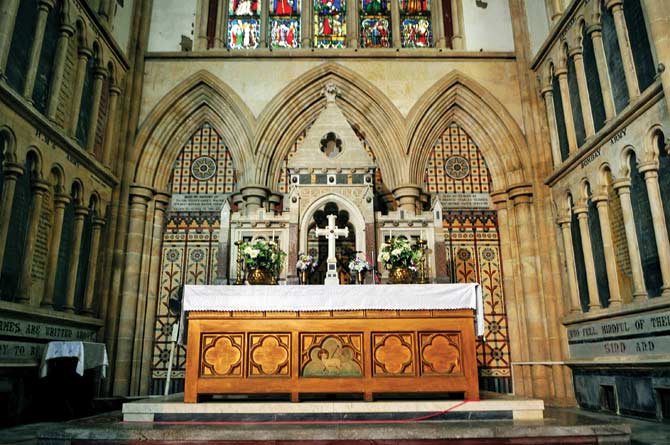The 158-year-old Afghan Church must be given its place of glory among Mumbai’s icons for its path-breaking architecture and legacy

 Sunday morning service. The sound of approaching horse carriages and a flurry of activity fills the air. Inside, sunlight filters in through magnificent stained glass windows. Inside an Anglican citadel, the congregation comprising of British officers and their families are seated in the front pews while the Indians are seated behind. Ringing bells resonate across the wooded cantonment, and possibly, beyond.
Sunday morning service. The sound of approaching horse carriages and a flurry of activity fills the air. Inside, sunlight filters in through magnificent stained glass windows. Inside an Anglican citadel, the congregation comprising of British officers and their families are seated in the front pews while the Indians are seated behind. Ringing bells resonate across the wooded cantonment, and possibly, beyond.

St John the Evangelist Church, commonly called Afghan Church. File pic
ADVERTISEMENT
It’s tempting to recreate the imagery of this Colaba landmark — St John the Evangelist Church, commonly called Afghan Church. There’s a July connect that made us jog our memory to this glorious example of the city’s Gothic influence. In the early 1840s, a temporary chapel was erected on Colaba Point at the entrance of the Bombay harbour. The area was meant to benefit British soldiers stationed at the cantonment. Two years after the conquest of Kabul in 1842, Bishop Carr of Bombay wrote to the English authorities of the need to erect a church in Colaba in memory of the martyrs in Afghanistan. Work began in 1847 and over a decade later, on July 7, 1858, the temporary chapel was replaced by the imposing church. Bishop Harding consecrated the church to St John the Evangelist. Its big draw, history books write, was its tower and steeple (60 metres, 198 feet) that was completed in 1865 and was visible from a fair distance. It served as a landmark for incoming ships to the harbour in the early days!
The designs were by Henry Conybeare, the then City Engineer. Its walls were built with coarse rubble from Coorla’s (Kurla’s) quarries, while fine carving in Porbander stone heightened its grandeur. Till date, historians and architects will agree that it was the first construction in the city to put local stone to imaginative use, probably setting a trend for church architecture in India. It worked wonders for Bombay in particular, as it required less maintenance thanks to its unforgiving tropical weather.
Even today, it’s not easy to take one’s eye off the detailed stained glasswork and carvings. Names of deceased soldiers who lost their lives during the Afghan campaign are etched in memorial plaques. Look even closer, and signs of cracks reveal a more painful saga. A few years ago, while on a visit, its caretakers and the resident pastor shared this concern – the lack of funds and experts to ensure its longevity and rightful place as a city landmark. Local patronage from a dwindling community and logistic issues make the path tougher. It’s a telling reminder of the condition that many such city treasures face. As Mumbai hails the UNESCO World Heritage Site status given to CST (formerly VT), we’d love to see a few eyeballs glance towards such icons as well who deserve a dekko before time plays spoilsport.
mid-day’s Features Editor Fiona Fernandez relishes the city’s sights, sounds, smells and stones...wherever the ink and the inclination takes her. She tweets @bombayana. Send your feedback to mailbag@mid-day.com
 Subscribe today by clicking the link and stay updated with the latest news!" Click here!
Subscribe today by clicking the link and stay updated with the latest news!" Click here!







